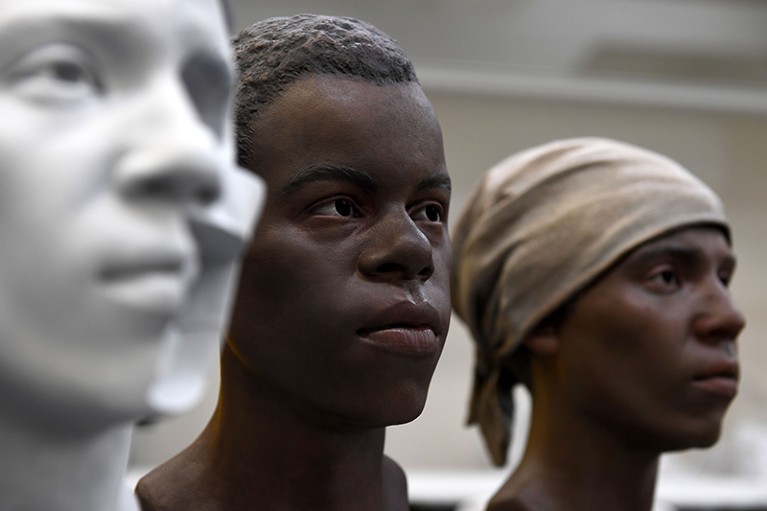Anthropology
Related: About this forumAncient DNA reveals the living descendants of enslaved people through 23andMe
NEWS
03 August 2023
A landmark genomic study raises the possibility that many more people could find links to distant ancestors through genetic analysis.
Ewen Callaway

Facial reconstructions based on the excavated remains of enslaved African Americans who worked at the Catoctin Furnace iron forge in Maryland in the late 1700s or early 1800s.Getty/Washington Post
Starting in the 1770s, hundreds of enslaved and free African Americans lived and worked at an industrial iron forge in Maryland. Dozens died at the Catoctin Furnace, their remains and lives largely forgotten until 1979 when part of the site was excavated to make way for a highway.
Now, in a landmark study, researchers have analysed DNA from more than two dozen people who were buried at the Catoctin Furnace and used that information to identify tens of thousands of living descendants whose data were in a consumer genetics database.
The study1, published on 3 August in Science, could open the floodgates to linking the genomes of historical people to their present-day descendants — some direct, but most very distant. This approach could be especially resonant for African Americans and other populations around the world who trace some of their ancestry to enslaved people, say researchers.
“Each time we are able to find an enslaved ancestor, we are defeating the purpose of slavery. The purpose of slavery was to rob us of that information,” says Henry Louis Gates Jr, a scholar of African and African American studies at Harvard University in Cambridge, Massachusetts, who was part of the effort. “This is a major development in the history of the use of genetics to trace ancestry.”
More:
https://www.nature.com/articles/d41586-023-02478-9
Faux pas
(16,060 posts)Judi Lynn
(164,045 posts)Judi Lynn
(164,045 posts)by JONATHAN SHAW
8.3.23
AGENETIC ANALYSIS OF AFRICAN Americans who labored at a Revolutionary War-era forge for the first time connects ancient DNA to living people who have shared their data in a genealogical database. Researchers used techniques originally developed for analyzing DNA that is tens of thousands of years old to develop genetic profiles of 27 individuals who had been buried in the late eighteenth and early nineteenth century at Catoctin Furnace in Maryland, and then linked them to more than 41,799 living relatives in the United States: customers of personal ancestry and health firm 23andMe who had agreed to share their genetic information. At a time of rising national interest in the legacy of American slavery—including Harvard’s own examination of its past—the research may spark new conversations about these emotional and increasingly politicized subjects.
“Recovering African American individuals’ direct genetic connections to ancestors heretofore buried in the slave past is a giant leap forward both scientifically and genealogically, opening new possibilities for those passionate about the search for their own family roots,” said Fletcher University Professor Henry Louis “Skip” Gates Jr. in a statement released by Harvard Medical School (HMS). Gates, who is director of Harvard’s Hutchins Center for African & African American Research and a coauthor of the paper, is the host of the popular genealogy and genetics television show Finding Your Roots.
When comparing the retrieved DNA to that in the contemporary anonymized database, the researchers found that the highest concentration of close relatives is in Maryland, suggesting that “descendants of the Catoctin individuals remain in the area.” More than 271 slaves labored at Catoctin Furnace, which supplied munitions to George Washington’s Continental Army during the Revolutionary War. In 1780, for example, the forge delivered 31 tons of 10-inch bombshells, many of which were used in the siege of Yorktown a year later. To produce iron, the slaves and an unknown number of free African Americans mined ore, cut wood, and labored as: colliers, who transformed the wood into charcoal to fuel the furnace; teamsters, who hauled charcoal and ore; and fillers, who dumped charcoal, ore, and limestone (used as flux) into the tunnel that led into the blast furnace. Others may have worked at domestic and agricultural tasks in the furnace owners’ households and plantations.
Tracing African American family lineages to ancestors who died before the 1870 census, in which all black people were listed by name for the first time, is notoriously difficult. At Catoctin Furnace in 1979, planning for a state roadway had unearthed skeletal remains at what was identified as an African American cemetery that had been in use at the Forge prior to 1850. Archaeologists documented the site, and the state of Maryland turned the bones over to the Smithsonian Institution.
More:
https://www.harvardmagazine.com/2023/08/tracing-slaves-to-modern-descendants
mzmolly
(52,585 posts)JoeOtterbein
(7,863 posts)...(tears).